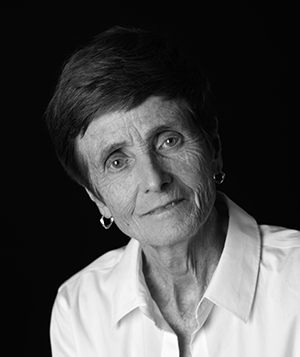
By Margaret Toomey, as told to Tim Paluch
Photographer: Duane Tinkey
Margaret Toomey spent nearly three decades managing Des Moines’ Oakridge Neighborhood, working with the community to provide services and programs for the low-income public housing complex. Since leaving in 2001, the onetime Dominican nun has continued her dedication to Iowa youth by teaching at-risk students with Des Moines Public Schools. In a conversation condensed by dsm contributing writer Tim Paluch, Toomey recalls her journey, from joining, and later leaving, the convent, to adopting traumatized children as a single mother, to, at age 78, continuing to pursue her lifelong commitment to serving others.
Seek to fulfill your personal mission
I was born in Chicago, on the west side. I went to St. Catherine of Siena grade school and Trinity High School. And then I went into the convent.
I graduated from high school in, I want to say, 1955. Sounds forever ago, doesn’t it? Becoming a nun really wasn’t a difficult decision. I knew that’s what I wanted to do. Even throughout high school, I was very service-oriented. I’ve always had a sense of mission.
My first teaching assignment was in Whitefish Bay, Wis. We had built a brand-new school there, a Dominican (Catholic) high school, in a well-to-do suburb.
I taught English, theology and, believe it or not, Latin, there for eight years, and then I got transferred to Madison, Wis. I taught there for three years, at Edgewood High School.
I was very lonely there. So I asked for time off and I went to Mendota State Mental Hospital in Madison to be a chaplain in training. And I loved that. I lived on campus, and I really liked the freedom of that.
Then I sought out a campus ministry position, and one was available in Des Moines. The director of campus ministry at Drake University, Father Nick Tormey, hired me in 1972 to work with the community college and a couple of other places to establish a Catholic presence. That’s how I got started here.
I did not want to live in a convent. So I went around looking for places, and I ended up over at River Hills. And a young man I had never met, I was telling him what I was looking for, and he brought me to the Homes of Oakridge.
I liked the people. As a resident, I got elected to serve on the board of directors and then to serve on the management committee. Then, the manager disappeared overnight. He carried his gun so people could see it. I was still a nun, so I had to ask the bishop and my superiors for permission (to accept the position of manager). I got the bishop’s approval and became the manager.
Work with others to achieve your goals
We had almost 400 kids at Oakridge, and they had no programs, no services. A couple of outreach workers, that’s it. That’s when we started developing both human services programs and our youth education and work program. You drive by Oakridge now and see this beautiful playground—it was a blank field then.
I had a good board of directors and people like former mayor Dick Olson and Bill Knapp, who was one of our greatest funders. Bill and I went together to most of the contacts in the community, and he helped us in enormous ways.
The wading pool there happened one summer when an infant died because we didn’t have any air conditioning in the apartments. So I wanted a wading pool, and Dick Olson said, “You raise half and I’ll give you the other half.” And so we did.
I could never have done it alone. We needed a team.
We had serious gang activities. We were moving some people in from Chicago—grandmothers with grandchildren—but it brought the Vice Lords, too. So we had a period (in the late 1980s and early 1990s) where we had terrible problems. We had marches involving the corporate community—“Up with hope, down with dope”—and Bill Bennett, who was the federal drug czar under George H.W. Bush, came and held a rally here.
The thing people always ask me: How come I didn’t get hurt? And I think the thing that made a difference is we provided employment; we tried to improve the living conditions of the apartments; and we provided programs and services. And I think when you provide services like that for people’s children, they recognize it.
Put family first
I left the convent, basically, because I wanted children. I’m not sure I was thinking so much about marriage, but I just wanted kids. I wanted the freedom. I didn’t leave the church, ever, but I had to get dispensation from my vows. So I did that, and then
I got a house, right off University, 1223 15th Place. It was my first home. I had foster children, but I wanted my own. And that’s when I began adopting.
I wrote to attorneys, and finally I got a call. There was a little girl that had been born 2 pounds, 3 ounces, and she went down to 1 pound, 13 ounces. And she was available for adoption. First I went to see her at Mercy. She was in the infant care nursery, the cutest little thing you ever want to see, but talk about small. Katie was in the hospital for two months. Finally she went home. She didn’t even have the sucking instinct.
I did not want Katie to be an only child. I was also thinking about my age, as a single parent. So I went through DHS (the Iowa Department of Human Services), and they placed a child with me. Timmy was about 4 months, and I kept him until he was about 11 months. Then the grandparents changed their mind, and I thought I would never ever ever ever adopt again. It was terrible.
But then they called me and said Tony was available for adoption. They told me to go see him. He was a terribly traumatized baby, whose older brother had been killed in the home, shaken baby syndrome. Tony was 18 months. So I went over there, to this house, to meet him. He was walking around and he wouldn’t talk, and he walked out of the room. I told my friend, “He doesn’t like me.” And a few minutes later he came back and he sat on my lap. I was hooked. Then they called me to tell me his little sister Nellie was born. So I went over to Broadlawns to get her. Nellie is now 24, Tony is 26, Katie is 30. Both Nellie and Tony were born cocaine-addicted, with hepatitis. At first, when Nellie was born, the social worker had to bring her in with rubber gloves.
So I had the three. And at one point we decided to adopt one more. And that’s my youngest, Shavion. He’s going to be 20. His mother was super young. She was under court supervision, so he was in a foster home and eventually they wanted to put him in more permanent placing.
Teen years were the hardest. As they get into high school, they start to question their roots. And it’s hard. But I never missed a parent conference. I never missed a ballgame. I never missed any sort of counseling appointment. I kept them involved in as many activities as they could possibly do.
Some days you feel stronger than others, but they were always my No. 1 priority, even though, unfortunately, I had to work all the time. If I have any regret, sometimes I wish I had done a better job at times. … I wish I would have been more patient with them.
Use the arts to learn and heal
Toomey left Oakridge in 2001 and began working for Des Moines Public Schools.
I still teach full time. The program I’ve worked in for the last 10 years is with Children and Families of Iowa. I’ve had two group homes, one for boys, one for girls. Last year they closed the boys’ program, which made me sad. But they are continuing the girls’ program. As kids get stabilized through their trauma-based care, they are brought to our school, and then if they’re doing well, we eventually start them back into public school.
About two years ago, I heard of Movement 515, Brave New Voices. So
I contacted Kristopher Rollins and Emily Lang, the organizers, and I told them, “We need this,” because so much of our kids’ therapy is left side of the brain, structured. But they have stories to tell, and they will tell it in metaphor and poetry.
I could see we needed more than just the typical classroom education, and work-in-your-book and test-taking and all that kind of stuff. The arts are healing. And when you hear some of their poems, you want to weep. I have seen kids who thought they were nothing and then they get hooked on poetry.
So many of these youngsters have been abused, oppressed, neglected, exploited, beaten, raped. What kind of self-esteem does that build? So the process of healing is very important. My biggest concern is, I’m on them to finish their coursework and get those credits and graduate. You have to constantly keep your goal in mind.
I enjoy what I do. I’m going to be 79. As long as my health holds out and I make sense, I’ll continue teaching.
Lead by example
My leadership has always been more of a facilitator. I go out and find people willing to help. And then we become a team. Every time I hear of a good thing, I pursue it. That’s what I really would want to be remembered for. Being a team player and bringing in resources needed for children and youths in the area of housing and services and education. After I’m gone, I just want some of these programs to continue to support the kids.
I think you have to walk the same path. You have to get on people’s level. I don’t think you lead a group; you walk with a group. I found that dominating people doesn’t work. But working with people and being a good leader does. You can’t be a dictator.
The students I teach, you can set the structure and the parameters but you’ve got to be open to, “Can we do it this way today, Miss Toomey?” Right now they don’t want to hear a 50-minute lecture from any teacher.
Stay active and engaged
I’m just finishing a photography class at the Art Center. And I do try, three or four times a year, to go out to dinner with people. I’m going to join the Y. I don’t want my family to worry about my mental health, worry if I’m lonely or not. I also have to develop more of a life outside of my family and be there more as a supporter and not let them think I can’t be independent of them. I don’t want to be sitting here lonely, thinking, “When are they going to come home? Are they going to abandon me?”
In 1998, Toomey received an honorary degree from Drake University for her work in the community and gave a speech at the ceremony.
I think that particular speech probably reflects a lot of my philosophy. I cited Robert Frost a couple of times, his “Stopping by Woods on a Snowy Evening” and “The Road Less Traveled.” Like him, I stood before two paths and couldn’t decide which way I would go. “I took the one less traveled by and that has made all the difference.” And I ended by saying, quoting Frost, “But I have promises to keep, and miles to go before I sleep, and miles to go before I sleep.”










